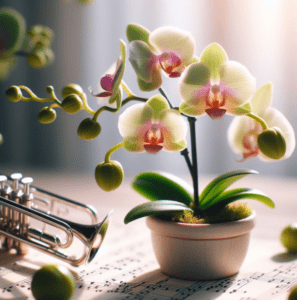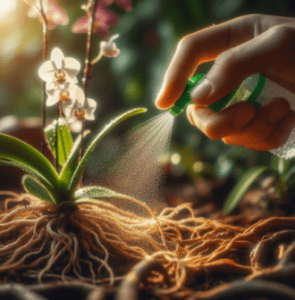
Ready to discover the joy of orchids? Don’t let their exotic looks intimidate you! With Orchid Care for Beginners, you’ll learn the secrets to keeping these beauties happy and blooming. We’ll cover the right light, watering, and more for stunning flowers you’ll be proud of!”
Choosing Your First Orchid
- Phalaenopsis Power: Moth orchids are the perfect beginner’s choice – forgiving, long-blooming, and easy to find!
- Healthy = Happy: Look for firm, green leaves and plump roots. Avoid plants with yellowing foliage, mushy spots, or fading flowers.
- Size Matters: Start with a medium-sized orchid. Mini ones can be trickier, while huge plants are a bigger investment while you’re learning.
The Right Light for Thriving Orchids

Orchids crave bright, indirect light – think of the dappled sunlight they’d get through leaves in the rainforest. An east-facing window is ideal. Too much sun? You’ll see brown scorch marks on the leaves. No blooms for ages? Your orchid might need more light.
Need a Boost? A simple LED grow light can help your orchid thrive if your home is dim.
Watering & Humidity: Your Orchid’s Hydration Guide

- Orchids Hate Soggy Feet!: They naturally get their water in quick bursts in the rainforest, followed by drying periods. Mimic this at home!
- The Touch Test: Before watering, poke your finger into the potting mix. Feel mostly dry with a hint of moisture? It’s watering day! Still quite damp? Wait!
- Humidity Helper: Most homes aren’t as humid as an orchid’s jungle home. Consider a pebble tray (pot sits on pebbles in water-filled tray), a humidifier, or grouping plants for a moisture boost.
Temperature & Airflow: Simple Comforts for Happy Orchids
- Cozy, Not Extreme: Most common orchids thrive in daytime temperatures of 65-80°F with slightly cooler nights (55-65°F). Small temperature drops can even trigger blooming!
- Avoid Drafts & Blasts: Keep your orchid away from cold drafts or air conditioner vents. They dislike sudden temperature changes.
- A Gentle Breeze is Best: Good air circulation prevents disease. A small fan nearby is like a refreshing tropical wind for your orchid!
Fertilizing: Less is Truly More!

- Light Feeders: Orchids don’t need much fertilizer. Use a balanced orchid fertilizer diluted to half strength (or even weaker!).
- “Weakly, Weekly”: Feed with your diluted fertilizer every other watering during the active growing season (usually spring-summer). Go easy during winter.
- Flush it Out: Once a month, water your orchid with plain water to rinse out any fertilizer buildup in the pot.
Repotting: Only When Needed
- Signs it’s Time: Roots poking out everywhere, soggy potting mix, or an unstable plant are reasons to repot.
- Potting Perfection: Choose a slightly larger pot and use a well-draining orchid mix (bark, perlite, moss).
- Video Helper: Repotting can seem daunting. Search for online tutorials to see it done step-by-step.
When Orchids Finish Blooming
- Don’t Panic! It’s normal for orchid flowers to fade. This is a rest period, not the end!
- Rebloom Potential: How you encourage reblooming depends on your orchid type. With Phalaenopsis, cutting the flower spike often triggers new blooms.
- Patience Pays Off: Don’t discard your orchid after blooming! With continued care, it will reward you with more flowers.
Troubleshooting Common Orchid Issues
- Yellowing Leaves: Usually from overwatering. Check the roots – mushy means rot!
- No Flowers: Often a light issue. Orchids need energy to bloom. Some types also like a slight nighttime temperature drop to set buds.
- Pests: Mealybugs and scale can be a problem. Treat early with insecticidal soap or neem oil.
Beyond the Basics
Let’s explore popular orchid varieties, tips for continued success, and how to handle challenges as your orchid journey unfolds!
Popular Orchid Varieties: Finding Your Perfect Match
- Phalaenopsis (Moth Orchid): The classic starter orchid – easygoing and long-blooming.
- Dendrobium: Boasts amazing variety in colors and forms. Many tolerate various light conditions.
- Oncidium (Dancing Lady Orchid): Known for cheerful sprays of small, often intricately patterned flowers.
- Cattleya: Prized for large, fragrant blooms. Needs good light and can be slightly more demanding.
Tips for Continued Success
- Adapt with the Seasons: Adjust watering and light slightly with changing seasons.
- Airflow is Key: A gentle breeze helps prevent disease.
- Repotting Alternatives: If roots are healthy but the potting mix is old, you can sometimes just change the mix.
- Learn from Your Blooms: Flower size, shape, and number can offer clues to your orchid’s health.
Special Considerations
- Miniature Orchids: Dry out faster between waterings due to small pots.
- Mounted Orchids: Need frequent misting or soaking as their roots are exposed to air.
- Terrestrial Orchids (Ground Orchids): They have different potting mixes and watering needs.
The Joy of Orchids Orchid care is an ongoing journey of learning and discovery. Embrace the process, celebrate the victories, and revel in the beauty these extraordinary plants bring into your life!
Conclusion
Armed with an understanding of the basics, care for specific types, and advanced tips, you’re unlocking the full potential of your orchid journey. Let exploration, learning, and love for these extraordinary plants guide you!

























